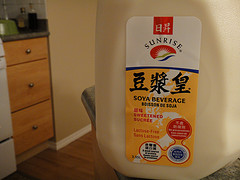
flic.kr/p/9vpQMp
With more than 5,000 years of soybean cultivation, China is widely considered as the home of the oil crop. And as an essential derivative of soybean, lecithin production also forms a significant percentage of China’s industry.
Lecithin China is a phospholipid that is derived primarily from soybean. It is comprised mainly of polar and neutral lipids and glycerol, a phosphate group, and choline. Although lecithin may also be extracted from egg yolk, a big chunk of the commercial lecithin available in the market today come from soybean.
Lecithin China differs in color from light tan to dark reddish brown. In terms of consistency, it also differs from fluid to a plastic solid. During soybean processing, a thick gummy material is normally produced as a by product of the crude soybean oil. This gummy material is where you can see lecithin China.
How to produce Lecithin China
Lecithin China is one of the most essential derivatives of soybean processing. The crude soy oil contains an average of 1.8% hydratable compounds, mainly lecithin phosphatides. Through a process termed “degumming,” the sludge (the gummy material) is separated from the crude soy oil by the use of a centrifuge.
The result is a lecithin China and water emulsion containing 25-50 percent water, which may be bleached typically with hydrogen peroxide in order to reduce its color from brown or beige to light yellow. Some manufacturers add fluidizing additives such as fatty acids, soy oil, or calcium chloride to the product in order to reduce the viscosity to that of honey and prevent it, while cooling, from becoming a highly plastic solid. Lastly, the lecithin China product is film or batch dried to lessen the moisture to as little as 1%.
Main Functions
Lecithin China is ubiquitous in the processed food supply since its discovery in the 1930s. As an emulsifier, it is often used in peanut butter, chocolate candies, margarine, ice cream, coffee creamers, and infant formulas. Additionally, because of its keeping abilities, lecithin China also helps prevent product spoilage, extending shelf life in the marketplace.
Lecithin China is also handy around the industry kitchens where it is primarily utilized in improving mixing and speed crystallization. As one of the few emulsifiers in the market considered by the US Food and Drug Administration as Generally Regarded As Safe for use, lecithin China is also used to prevent stop spattering, “weeping,” and lumping and sticking during cooking.
Other than the commercial food industry, many industries also benefit from lecithin China. For example, it is used in cosmetics as a product that could soften the skin and help other ingredients penetrate the skin barrier.
Health Benefits
For many years, Lecithin China has been used as a treatment for a variety of illnesses. It has been said to remedy conditions, such as liver cirrhosis, gall stones, atherosclerosis, multiple sclerosis, psoriasis, eczema, scleroderma, anxiety, tremors and brain aging.
A leading purveyor of lecithin China since the 1920s, Dr. A. A. Horvath claims that the compound may be used as a “nerve tonic” or to help alcoholics lessen the effects of intoxication and withdrawal. There was also an article entitled “A Comfortable and Spontaneous Cure for the Opium Habit by Means of Lecithin” which was written by Chinese researchers.
Tagged with: lecithin benefits • lecithin overview
Filed under: Lecithin